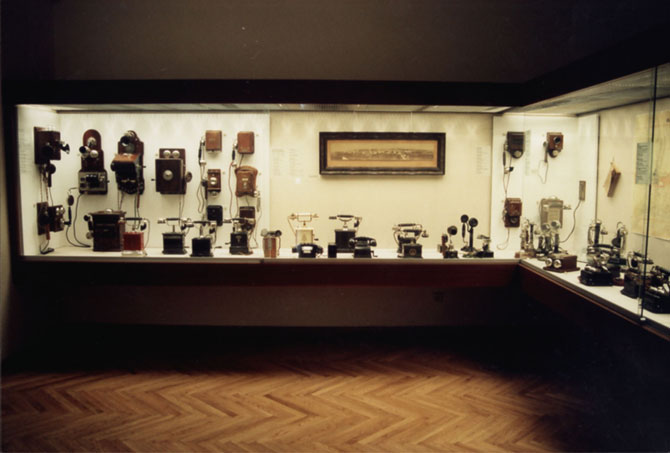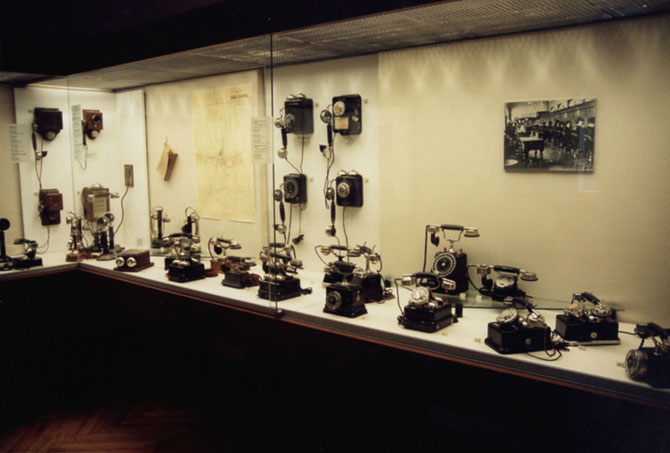Zagreb Telephony – the Zlatko Ivković Telephone Collection
Exhibition concept: Zlatko Ivković, Ivan Ružić
Exhibition design: Ivan Ružić
 Fast and accurate transmission of information and the possibility of equally accurate and fast reception of information is one of the basic postulates of the development of telephony.
Fast and accurate transmission of information and the possibility of equally accurate and fast reception of information is one of the basic postulates of the development of telephony.
Formerly, the news (information) were sent and received in various ways, by various means using prearranged signs, speech, signals and letters. Each of these examples had inherent drawbacks hindering technical developments and enhancing the need for something new – simpler, faster and more accurate.
Discovery of electricity opened new avenues to formerly inaccessible fields. Through application of electricity and understanding of its potential, conditions were created for long distance transmission of voice and – most important – at a speed greater than the speed of light. Experiments and thorough research lead to the invention of telephone.
Telephone is a device for transmission of speech across distance, operating by means of at least two electrically interconnected handsets, each consisting of a microphone and a receiver.
On March the 10th, 1876 after three days of hard work and three mostly sleepless nights spent in the laboratory, acid accidentally spilt on Alexander Graham Bell's hands resulted in the famous sentence: “Mr. Watson, come here, you are needed”.
For days, Alexander Graham Bell and his assistant Thomas Watson had been testing a device for transmission of sound and – at the very moment when Watson was in the other room – the first words were transmitted and clearly and loudly heard over what we today call the telephone. The cry for help, uttered by the inventor of the telephone Alexander Graham Bell, marked the beginning of simple, fast and accurate transmision of information.
Simplicity, speed and accuracy of transmission of information assured that – unlike any other technological invention up to that time – the telephone conquered the world in just a few years. Today, it is impossible to imagine our everyday life without it.
A year after that momentous event, the first telephone line was established between Washington and Baltimore and on the 25th of November, 1878, the first public telephone network was installed in New Haven, in the USA. Europe was quick to follow and the first telephone lines were laid in Germany approximately at the same time.
 In the year 1880, the Municipal Authorities of the City of Zagreb decided to install the first telephone line connecting the Urban Development Department in the Upper City with the City Waterworks (on the site of the present Western Railway Station). Implementation of the decision was temporarily delayed by the destructive earthquake that shook the city, but was soon resumed. The line was finished and the first telephone conversation in Zagreb took place as early as the 8th of January, 1881.
In the year 1880, the Municipal Authorities of the City of Zagreb decided to install the first telephone line connecting the Urban Development Department in the Upper City with the City Waterworks (on the site of the present Western Railway Station). Implementation of the decision was temporarily delayed by the destructive earthquake that shook the city, but was soon resumed. The line was finished and the first telephone conversation in Zagreb took place as early as the 8th of January, 1881.
Public telephone traffic was introduced in Zagreb on the 1st of January, 1887 by Wilim Schwarz, who was granted the concession by the Ministry of Trade in Budapest. The exchange was in his house on Krvavi Most and the first telephone subscribers were the Tannery and the First Croatian Savings Bank.
On the 1st of January, 1894, The Post and Telegraph Administration announced the purchase of Schwarz' network which passed with all the equipment into the hands of the State; subscribers (144 of them) were connected to the State Network. When the new telephone exchange was opened, the number of subscribers rose to 178. Originally, the exchange was located in Preradovićeva Street whence it was moved to Gajeva Street and later – in 1904 – to the new post-office building in Jurišićeva Street.
With its first telephone exchange having 7000 numbers, Zagreb entered the world of automatic telephony in 1928.
In 1939, Zagreb had 15 public telephone booths in the Post Office, 25 automatic street telephone booths and one private automatic telephone booth.
The telephone that we use today is the result of efforts and perseverance of many people and it is they who deserve our gratitude for making communication easier and life more comfortable. This exhibition – a survey of that process – is an opportunity to remember them all.
Zlatko Ivković, Ivan Ružić
About Zlatko Ivković
 Born in Zagreb in 1949, he acquired first insights into telephony and its history during his school years.
Born in Zagreb in 1949, he acquired first insights into telephony and its history during his school years.
The beginnings of his passion for collecting old telephones can be traced back to 1974, when he acquired a telephone set dating from 1937. That metal table apparatus aroused Zlatko's curiosity and was the starting point of his unique collection of over a hundred telephones, covering the period from the earliest days of telephony to the nineteen forties.
Since at that time everywhere in the world the telephone sets were property of the State and destroyed when superseded by new models, and since most of manufacturers of that period have ceased to exist with very few written production data preserved, the great value of this collection is obvious.
With time, the scope has expanded to include literature on telephony, old telephone directories and – additionally – restoration of telephone sets and their parts. The collection grew assisted by cooperation with various institutions and private collectors in the former Yugoslavia and by purchase and exchange of telephone sets and parts at the antique fairs in Zagreb, Budapest, Pecs, Vienna and Frankfurt. In some instances, it took 10 years to complete a telephone set and make it operational – an example of genuine collector's passion. Each set and even each of its parts has its own story and hides its own secrets. People who, together with Zlatko, have restored both bodies and souls of these phones are also a part of this collection, and deserve all his gratitude and heartfelt thanks. His thanks go to the master-galvanizer Mr. Emil Pikutić and the PATAFTA workshop; to Mr. Ivica Klarić, the varnisher; to Zlatko's father, master-turner Slavko Ivković; to Mr. Josip Turcer; to Mr. Zvonko Dorić, friend, fellow-collector and master creator of copies of old sets, and to all those who showed understanding for his passion, helped and supported him over the years.
Pictures from the exhibition





